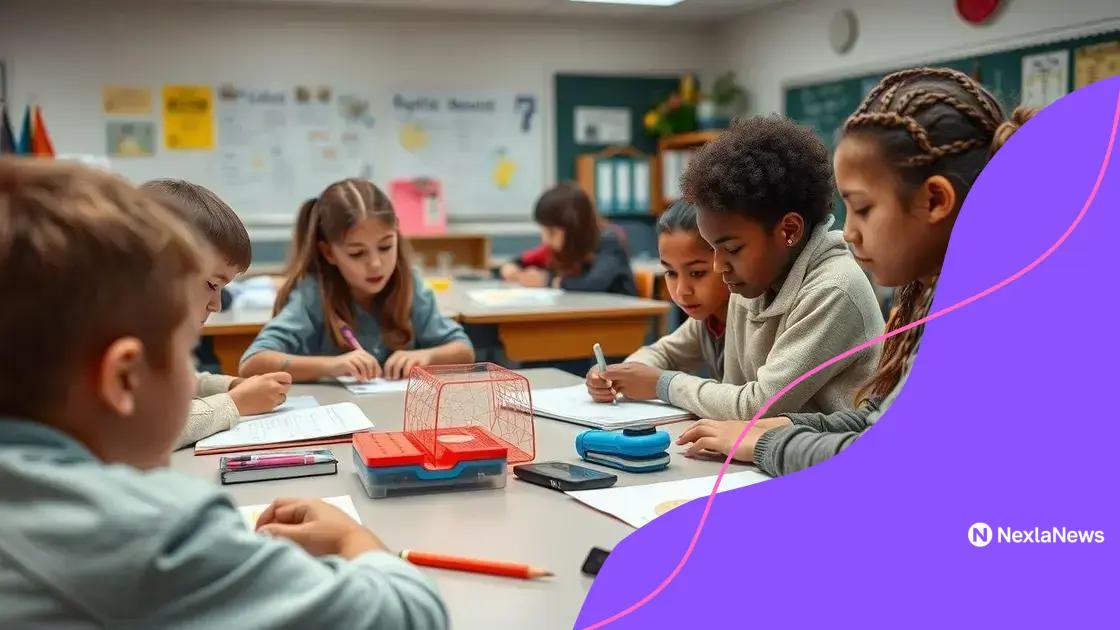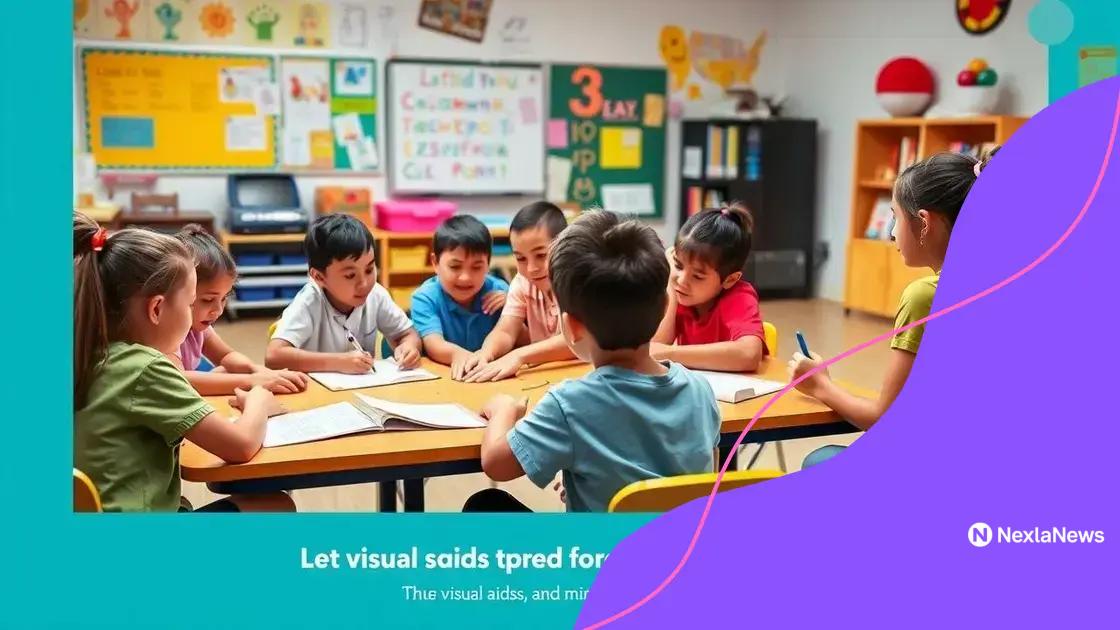Application of cognitive science in education can transform learning

The application of cognitive science in education enhances learning through personalized learning, artificial intelligence, social-emotional learning, and immersive technologies like virtual reality, creating more effective and engaging educational experiences.
The application of cognitive science in education is changing the way we understand learning processes. Have you ever wondered how our brains can best absorb information? This article explores innovative insights that could improve educational practices.
Understanding cognitive science basics
Cognitive science is an exciting field that seeks to understand how our minds work. This area combines psychology, neuroscience, artificial intelligence, philosophy, linguistics, and anthropology. By studying these connections, we can gain insights into how people learn, think, and remember. Understanding these basics is essential for applying cognitive science effectively in education.
Key Concepts in Cognitive Science
To grasp the essence of cognitive science, it’s important to focus on several key concepts. These include:
- Memory: How we store and recall information affects learning.
- Learning Processes: Understanding how individuals acquire knowledge can enhance teaching.
- Problem Solving: Cognitive science explores how we tackle challenges and make decisions.
- Language: The relationship between language and thought is critical.
Each of these concepts plays a crucial role in shaping how we approach education. For example, memory techniques can help students retain information longer. Teachers can adopt methods that promote better retention and recall.
Applications of Cognitive Science
Education can benefit greatly from cognitive science. Research provides strategies to create effective learning environments. Active learning is a prime example. By engaging students, they are more likely to remember what they learn. Moreover, understanding cognitive load helps educators design lessons that don’t overwhelm students.
Addressing students’ individual learning styles is another valuable approach. Cognitive science suggests using diverse teaching methods to reach all types of learners. This can include visual aids, hands-on activities, and collaborative projects.
As we continue to explore the basics of cognitive science, the implications for education are vast. By applying these principles, educators can foster a deeper understanding of how students learn, ultimately leading to improved outcomes in the classroom. The interdisciplinary nature of cognitive science offers a rich foundation for enhancing educational practices.
How cognitive science enhances teaching methods
Cognitive science plays a pivotal role in enhancing teaching methods. By understanding how students think and learn, educators can tailor their approaches to meet individual needs. This can lead to more effective and engaging lessons in the classroom.
Active Learning Strategies
One powerful way cognitive science enriches teaching is through active learning. This approach encourages students to participate in their learning process rather than passively receiving information. Active learning can include:
- Group discussions: Students exchange ideas and challenge each other’s viewpoints.
- Hands-on projects: Engaging in real-world problems promotes critical thinking.
- Case studies: Analyzing specific situations helps students apply what they learn.
- Interactive technology: Utilizing apps and educational software keeps students engaged.
These techniques not only make lessons more interesting but also improve retention and understanding of the material.
Feedback and Assessment
Another important aspect is the use of feedback and assessment techniques informed by cognitive science. Regular feedback helps students identify their strengths and areas for improvement. Formative assessments allow teachers to gauge understanding throughout a lesson. This way, they can adjust their methods based on students’ needs.
Moreover, the concept of growth mindset is vital. Teaching students that abilities can be developed through effort fosters resilience and encourages them to tackle challenges. This mindset can change how students perceive failures and successes, leading to a more positive learning experience.
Further, differentiated instruction supports individual learning styles. Recognizing that students have unique preferences and paces, educators can offer varied approaches within a single classroom, personalizing the learning experience.
As cognitive science continues to evolve, it opens up new opportunities for improving teaching methods. By integrating these insights, educators can create a richer, more engaging educational environment for all students, ultimately leading to better outcomes and a love for learning that lasts a lifetime.
Practical applications in classrooms

Practical applications of cognitive science in classrooms can revolutionize the way students learn. By using research-based strategies, teachers can create environments that promote understanding and retention of information. Implementing these techniques can lead to more productive and engaged learners.
Collaborative Learning
One effective approach is collaborative learning. This method encourages students to work together, sharing knowledge and ideas. When learners collaborate, they are likely to engage more deeply with the content. Here are some benefits of this approach:
- Peer learning: Students can explain concepts to each other, reinforcing their own understanding.
- Diverse perspectives: Working with others helps students see different viewpoints, enriching their learning experience.
- Enhanced social skills: Collaboration fosters teamwork, communication, and conflict-resolution abilities.
Incorporating collaborative projects or study groups can enhance the learning experience, making lessons more dynamic and interactive.
Mindfulness Techniques
Another practical application is the use of mindfulness techniques in the classroom. These practices help students focus their attention and reduce anxiety. Simple activities, such as guided breathing exercises or short meditation sessions, can improve concentration and overall well-being.
Additionally, implementing mnemonic devices is a great way to aid memory retention. Methods like acronyms or rhymes can make learning complex information easier. For example, teaching students to use acronyms for scientific terms can help them remember definitions more effectively.
Using visuals, such as mind maps or diagrams, also aligns with cognitive science principles. Visual aids can simplify complex topics and aid in comprehension. Students often find it easier to grasp ideas when they can see them represented visually.
As educators embrace the practical applications of cognitive science, they can create classrooms that nurture critical thinking and creativity. By prioritizing these strategies, teachers help students develop the skills they need for success in the 21st century.
The role of technology in cognitive science
Technology plays a crucial role in the field of cognitive science, enhancing both research and educational practices. Through advanced tools and applications, we can delve deeper into understanding how our minds work and apply these insights in the classroom.
Enhancing Research
One significant impact of technology is in cognitive research. Tools like brain imaging technologies allow scientists to observe brain activity in real-time. For example, techniques such as functional magnetic resonance imaging (fMRI) help researchers study how different areas of the brain are activated during various cognitive tasks.
Computational models also play a key role in cognitive science. They simulate human thought processes, helping researchers explore and predict how we think, learn, and remember.
Educational Technologies
In the classroom, technology can enhance teaching methods significantly. Smartboards, tablets, and educational apps engage students and provide interactive learning experiences. When students use these tools, they can reinforce their knowledge through multimedia content.
- Adaptive learning platforms: These tailor educational experiences to individual student needs and learning speeds.
- Gamified learning: Incorporating game elements into lessons increases motivation and enjoyment.
- Virtual reality: VR can create immersive experiences that mimic real-life situations, aiding understanding in complex subjects.
Moreover, online resources such as educational videos and interactive simulations make learning accessible beyond the classroom. Students can explore topics at their own pace, solidifying their understanding.
As technology continues to evolve, its integration with cognitive science will yield even more innovative approaches in education. Maintaining a balance between technological tools and effective teaching practices is essential to harness the full potential of cognitive science.
Future trends in education and cognitive science
The future of education is closely tied to advancements in cognitive science. As our understanding of the brain deepens, we can expect several key trends to shape how education is delivered. These trends will focus on enhancing learning experiences and improving academic outcomes.
Personalized Learning
One major trend on the horizon is personalized learning. This approach tailors education to the needs and preferences of individual students. By understanding how different students learn, educators can create customized learning paths that fit their unique styles.
Some aspects of personalized learning include:
- Data-driven insights: Utilizing data analytics to monitor student progress and tailor instruction accordingly.
- Differentiated resources: Offering various materials and methods to cater to different learning styles.
- Flexible pacing: Allowing students to learn at their own speed, ensuring mastery of content before moving forward.
Integration of Artificial Intelligence
The integration of artificial intelligence (AI) in education is another exciting trend. AI can enhance both teaching and learning by providing intelligent tutoring systems that offer personalized support. These systems can assess students’ strengths and weaknesses in real time, adapting their recommendations to improve outcomes.
Moreover, AI can automate administrative tasks for teachers, freeing up more time for instruction and interaction with students.
Emphasis on Social-Emotional Learning
As we move forward, there will be a greater emphasis on social-emotional learning (SEL). This focuses on developing emotional intelligence and interpersonal skills in addition to academic learning. SEL helps students manage emotions, set goals, and build positive relationships, which are crucial for their overall development.
Implementing SEL programs can support a well-rounded educational approach and create a positive school climate.
Finally, the use of technology in education will continue to expand. With the rise of virtual reality (VR) and augmented reality (AR), students will have the opportunity to experience immersive learning environments that enhance engagement and understanding. These technologies can bring complex concepts to life, allowing students to interact with content in ways that were previously unimaginable.
As we explore the future of education, the integration of cognitive science offers exciting possibilities. Personalized learning will help cater to the unique needs of each student, making education more effective. The use of artificial intelligence will change how teachers and students interact, while social-emotional learning will support students in managing emotions and building relationships. Embracing technology like virtual reality will create immersive experiences, enhancing understanding and engagement. Overall, the advancements in cognitive science will pave the way for a more adaptable and enriching educational landscape.
FAQ – Frequently Asked Questions about the application of cognitive science in education
What is personalized learning?
Personalized learning tailors educational experiences to meet the unique needs of each student, enhancing their learning outcomes.
How does artificial intelligence support education?
Artificial intelligence provides intelligent tutoring systems that adapt to students’ individual needs, helping improve their learning experience.
What is social-emotional learning (SEL)?
Social-emotional learning focuses on helping students manage their emotions, set goals, and build positive relationships, contributing to their overall development.
How can virtual reality enhance learning?
Virtual reality creates immersive environments that allow students to experience learning in a hands-on way, making complex concepts easier to understand.
